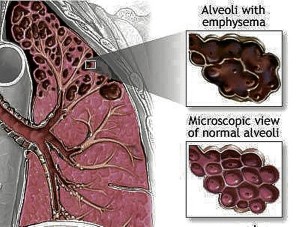PCCP, Novartis to raise public awareness on COPD

THIS shows how the small, balloon-like air sacs look like in individuals with COPD. Healthy ones fill up with air like a small balloon when breathing in and deflate as the air goes out. In COPD, the airways and air sacs lose their shape and become floppy, and thus, unable to efficiently take in enough oxygen to the body.
Did you know that the global scenario of diseases is now shifting from infectious diseases to noncommunicable diseases, with chronic conditions such as heart disease, stroke and chronic obstructive pulmonary disease (COPD) being the chief causes of death globally?
In fact, new estimates of the World Health Organization predict that COPD would be the third leading cause of death by 2030.
Much of the increase in COPD is associated with projected increases in tobacco use (including secondhand or passive exposure). The WHO estimates that tobacco-related deaths are projected to increase to 8.3 million deaths per year by 2030—a significant increase when compared to the current data of about 5 million deaths.
Aside from tobacco use, other significant risk factors of developing COPD are the continuous exposure to dust, chemicals as well as indoor smoke coming from cooking equipment that still use wood and charcoal.
Concerned
To raise this concern, the Philippine College of Chest Physicians teamed up with Novartis Healthcare Philippines to set up a program that would educate the public as well as doctors with continuing medical education on the diagnosis and management of COPD.
This partnership will culminate on Nov. 14 as the world observes COPD Day.
The COPD is not one single disease but an umbrella term used to describe serious lung diseases that over time make breathing harder. The more familiar terms such as “chronic bronchitis” and “emphysema” are just some of the conditions associated within the diagnosis of COPD.
Breathlessness, or a “need for air,” excessive sputum production and a chronic cough are just some of the classic indications of having COPD. The bad news is, this condition may progressively lead to death.
Currently, an effective COPD management plan would include assessing and monitoring the disease, reducing the risk factors, stabilizing COPD and managing the possible exacerbation of the condition (avoiding the development of deadly infections).
Many ways
Once you have been diagnosed with COPD, there are many ways that you could work together to manage the symptoms of the disease and improve your quality of life. If you smoke, the best thing you can do to prevent more damage to your lungs is to quit.
Your doctor or a pulmonary expert may even recommend some activities that help your arms and legs get stronger and/or breathing exercises that strengthen the muscles needed for breathing.
Another treatment option that is currently making news is a long-acting muscarinic antagonist called glycopyrronium bromide (developed by Novartis), a recently approved, once-daily inhaled maintenance bronchodilator treatment that is developed to relieve symptoms in adults with COPD.
Both European and Japanese regulators based their approval on data coming from the Phase 3 “GLOW” trials which showed that glycopyrronium bromide, when compared to placebo, significantly improved lung function over the first four hours after morning dosing and that this benefit was sustained for 24 hours over a 52-week period.
